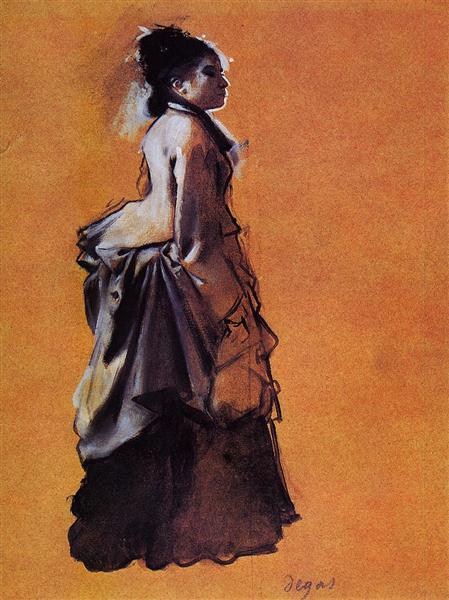Description
Edgar Degas's "Young Woman in Street Clothes", painted in 1872, presents a profound analysis of the complexity of everyday life and feminine elegance through the artist's technical and emotional mastery. In this painting, Degas reveals his fascination with the human figure, particularly in this young woman who has become an icon of 19th-century style and modernity.
The composition of the work is notable for its focus on the central figure, who is positioned at a slightly broken angle, suggesting movement and an imminent connection to the outside world. The young woman, in her traditional street dress that highlights her slender figure, becomes the focal point of the painting. Degas uses a subtle play of light and shadow to bring the folds of the fabric to life, emphasizing not only the elegance of her attire, but also the fluidity of movement it evokes. The choice of a neutral background allows the figure to glow and come to life, while the texture and detailing of the dress invites the viewer to appreciate the quality of the material.
The use of colour in this work is equally significant. Degas employs a palette that moves between soft warm and cool tones, suggesting not only the natural light that illuminates the woman, but also the multiple layers of her personality. Yellow and blue predominate, creating a visual balance that is both harmonious and dynamic. This treatment of colour is not only limited to the female figure, but also extends to the background, where the tones are blurred, taking advantage of the impressionist technique to conjure a light and ethereal atmosphere.
As for the figure portrayed, she is imbued with a sense of identity and an implicit history that could be shared by many women of her time. Although there are no other characters present in the painting, the implication of an urban setting is palpable. The young woman seems to be captured in a moment of introspection, as if she is about to embark on an adventure or simply taking a moment to reflect on her place in the world. The work suggests that although modern life may seem hectic and chaotic, there is always room for self-regard and beauty.
Edgar Degas, a pioneer of Impressionism and a key figure in late 19th-century art, often explored themes related to movement and everyday activities, especially in his depiction of dancers and women in Parisian urban life. Degas's focus on the human figure, as well as his analysis of time and space, distinguish him as an innovator in the use of color, light, and form. Other works, such as his ballet studies or his compositions of women in various activities, reflect his continuing quest to capture the essence of movement.
The “Young Woman in Street Dress” is not only a testament to Degas’ artistic mastery, but also a reflection of an era that was rapidly changing. Through this work, the viewer not only connects with the aesthetics of a woman of her time, but is also drawn into a dialogue about identity, modernity, and the female experience. This iconic work continues to resonate with contemporary audiences, challenging each viewer to find their own interpretation and connection to youth, elegance, and the transience of life.
KUADROS ©, a famous painting on your wall.
Hand-made oil painting reproductions, with the quality of professional artists and the distinctive seal of KUADROS ©.
Painting reproduction service with satisfaction guarantee. If you are not completely satisfied with the replica of your painting, we will refund 100% of your money.

